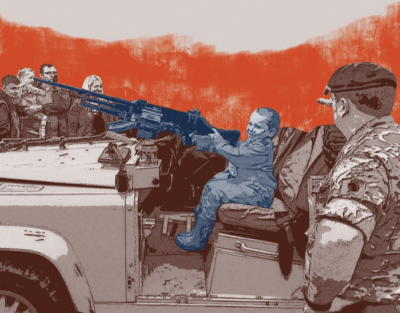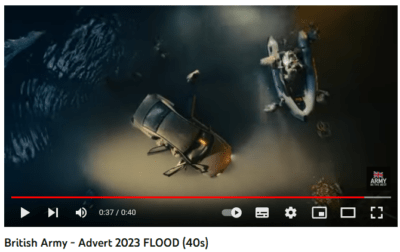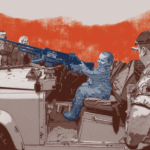Tory boost for cadets in schools needs fighting
ForcesWatch comment
This article was first published in the Morning Star.
The Defence Secretary, Michael Fallon, recently announced that 25 out of 150 proposed new school cadet units would soon be opening. (1) Despite the presentation of this development as new policy, the Cadet Expansion Programme (CEP) promoting cadet forces in state schools, was first announced in 2012.(2) Its first phase received over £14 million funding. (3)
In the 2015 budget, the Chancellor of the Exchequer announced £50 million of second phase funding from Libor fines, increasing the number of state school cadet units to 500 by 2020. (4)
In 2016 he announced a further half a million from Libor fines, to support seven Cadet ‘linked detachments’ in Scottish schools as well as £3.3m for Cadet Forces qualifications. (5)
While the Government heralds the cadets as a silver bullet in terms of improving pupil attainment and development, the sight of ranks of pupils as young as 12 in military gear and handling weapons will ring alarm bells for many. That this is happening within education raises additional concerns.
Cadet forces in schools are not new of course. Many independent schools have long run Combined Cadet Forces (CCF).
Now, it is the Department for Education (DfE) rather than the Ministry of Defence (MoD) promoting cadets and ‘military ethos’ in schools.
Figures suggest that 69 new units have been set up in state schools, with MoD funding, other bursaries and assistance of a partner CCF in an independent school. (6)
The ‘military ethos’ in schools programme also includes the far-from-successful Troops to Teachers scheme which fast-tracks veterans into teaching, and ‘alternative provision with a military ethos’.
The latter has led to privately run agencies being given public funds to provide military-style activities and ‘uniformed early intervention’ to both pupils at risk of disengaging from education and to whole classes, sometimes with a frequent presence in the school. (7)
The government argues, rather one-sidedly, that ‘military ethos’ is particularly able to instil ‘character’ and develop leadership and resilience in young people.
While there are undoubted benefits to students of being provided with well-funded resources to enrich their education, there is scant independent research into the efficacy of these schemes in relation to others that don’t happen to promote the country’s armed forces.
With the stated policy objectives of student and social development and its promotion by the DfE, it is easy to lose site of the ways in which school cadet forces allow the MoD to pursue its defence agenda amongst a captive audience. Why otherwise would the Government be particularly keen to support new cadet units in ‘areas where the MoD wants to raise awareness of the armed forces’? (8)
The MoD’s Youth Engagement Review of 2012 recognises the value of cadets in furthering both defence and ‘cross-government’ outcomes; as such they are more acceptable than armed forces visits to schools to promote careers. Despite protestations the ‘this is not about recruitment’, cadet units do serve as a channel for potential recruits into the regular and reserve forces. (9)
Cadet units also serve as a way to create ‘positive awareness’ about the armed forces in a far wider group of young people. Concerned about the growing unpopularity of military approaches to conflict resolution in the population at large, the military focus on those too young to have developed a critical awareness around such issues.
While perhaps only a minority of students will choose to join a cadet force, their uniformed presence is often highly visual across the school.
The challenge to those schools which turn to cadets to raise attainment and tighten up discipline is to keep space open for discussion and acceptance of nonviolent and non-military approaches to defence and conflict resolution. This is a significant challenge in the face of a culture of toys, films and games that, far more often than not, sanitise and glamourise the impact of warfare.
News coverage of one new cadet unit notes how the 12 year-old cadets will be handling live ammunition within a year. With the increase in weapon-related violence affecting young people, lauding of the tools for violence seems inconceivable, yet the armed forces regularly exhibit weaponry in schools, perhaps seeing it as one of their main selling points.
In this climate, it is not unreasonable to fear that failing to use the education system to explore the causes and consequences of violence, whether perpetrated by an individual or the state, and alternative approaches to it, will have consequences for our society in the future.
Such a perspective is too long-term for government thinking. Cadets and ‘military ethos’ in schools fit into a growing category of ‘quick-fix ideological education policy response’. By choosing to highlight the opening of the new cadet unit in the Rockwood Academy, one of the so-called ‘trojan horse’ schools in Birmingham, and closely linking it with a counter-extremism curriculum initiative, the government are sending a clear message that military values are equated with British values. (10)
We have yet to see what impact these poorly thought through policies will have on educational and learning values and on values that promote human rights and peace.
One effect may be that certain schools will feel pressured to subscribe to ‘military ethos’ programmes to demonstrate compliance with other government policy.
Certainly the expansion of cadets is being focused in ‘less affluent areas’ as well as towards pupils with low attainment expectations. (11) This in itself raises concerns around parity of opportunity both in the school experience and the career pathways offered. In some areas your child may have little choice but to have the military as a normal part of their school life.
So far, the take up of the government’s cadet offer has not been overwhelming. FOI figures recently obtained by Schools Week show that the number of state schools with cadet units only increased by 5 since 2015. (12)
And official statistics show that the number of young people in CCF units slightly declined in the last year. (13) This may reflect practical issues involved with setting up and running a unit within a school with few spare resources. It seems unlikely that such units will be able to continue into the future without considerable support from public funds.
It is far more heartening to see that many schools are routinely pursuing enrichment projects with more universal appeal and without the military uniform. None of the 2016 Character Awards were presented to military ethos projects, despite the Depatment for Education ring-fencing a third of the award money for them. (14, 15)
Away from Westminster, devolved education authorities are demonstrating a more cautious attitude towards expanding cadets units and armed forces activities in schools, giving greater recognition to what the Welsh Parliament have called ‘the unique nature of an armed forces career’. (16)
The Scottish Government have shown an unwillingness to promote the CEP although a limited number of ‘linked detachment’ partnerships between Scottish schools and their local army cadet forces were proudly announced by the Defence Secretary this year. (17, 18)
For now, however, it seems that the onward push towards greater military influence in UK schools is not slowing. The cadets forces are massively resourced institutions which have set their sights on state education, and this chimes with current government education policy and defence needs.
None are likely to give up the battle for the hearts and minds of the nation’s young people any time soon. We need to challenge the promotion of the military as a solution to social problems and its uncritical acceptance within education before it is too late to do so.
1. https://www.gov.uk/government/news/defence-secretary-helping-young-people-through-25-new-school-cadet-units
2. https://www.gov.uk/guidance/the-cadet-forces-and-mods-youth-work#cadet-expansion-initiative
3. http://forceswatch.net/news/government-funding-military-ethos-schools
4. http://www.civilsociety.co.uk/finance/news/content/20011/osborne_commits_millions_from_libor_fines_to_charities
5. http://www.civilsociety.co.uk/finance/news/content/21474/government_commits_57m_to_charities_from_libor_funds_and_tampon_tax
6. http://schoolsweek.co.uk/cadet-club-growth-slow-in-schools-one-year-after-50m-grant/
7. http://challengertroop.org/
8. https://www.gov.uk/guidance/cadet-forces-units-information-for-state-funded-schools
9. https://www.gov.uk/government/uploads/system/uploads/attachment_data/file/518690/HOCS_FOI2016___Attachment-_Number_of_Cadet_Forces_joined_the_Naval_Service_from_2010_to_2015.pdf
10. http://www.rockwood-academy.co.uk/news/rockwood-academy-students-sign-up-to-become-combined-cadet-force-recruits/
11. https://combinedcadetforce.org.uk/get-involved/cadet-expansion-programme
12. http://schoolsweek.co.uk/cadet-club-growth-slow-in-schools-one-year-after-50m-grant/
13. https://www.gov.uk/government/uploads/system/uploads/attachment_data/file/526131/MOD_sponsored_cadet_forces__statistics_2016.pdf
14. http://schoolsweek.co.uk/2m-more-earmarked-for-military-style-projects/
15. https://www.gov.uk/government/news/schools-and-organisations-recognised-for-instilling-character
16. http://forceswatch.net/blog/armed-forces-visits-schools-debated-welsh-assembly
17. http://www.heraldscotland.com/news/14210113.Tories_attacked_over_plan_to_recruit_Scotland_s_poorest_schoolchildren_as__cannon_fodder__for_British_Army/
18. https://www.gov.uk/government/news/cadet-pupils-on-the-march-as-minister-visits-scotland
See more: cadets, military in schools/colleges, recruitment, ForcesWatch, education
Like what you read?
> Sign up for our newsletter or blog notifications
> Support our work – from just £2 a month










